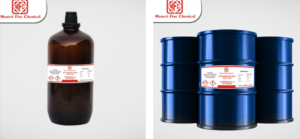Chlorosulfonic acids, represented by the chemical formula ClSO₃H, is a strong acid commonly used in various industrial processes, particularly in the synthesis of pharmaceuticals, dyes, and agrochemicals. Maruti Fine Chemicals is a reputable manufacturer and supplier of high-quality chlorosulfonic acids, catering to the diverse needs of industries worldwide.
Properties:
Chlorosulfonic acid, with the chemical formula ClSO3H, is a highly reactive, colorless to yellowish liquid. It has a pungent odor and is soluble in many organic solvents. This compound is extremely corrosive and can cause severe burns upon contact with skin or eyes. It reacts violently with water, releasing toxic fumes, and generating heat.
Uses:
Chlorosulfonic acid finds applications in various industries:
Chemical Synthesis: It is a key reagent in the synthesis of pharmaceuticals, dyes, and agrochemicals.
Organic Chemistry: Used in esterification, sulfonation, and chlorination reactions.
Polymer Industry: Employed in the production of specialty polymers and plastics.
Laboratory Research: Utilized as a catalyst and in chemical analysis.
Safety Measures:
Handling chlorosulfonic acid requires strict adherence to safety precautions:
Protective Gear: Wear appropriate personal protective equipment (PPE), including acid-resistant gloves, goggles, and a lab coat.
Ventilation: Work in a well-ventilated area or under a fume hood to prevent inhalation of toxic fumes.
Handling: Avoid direct contact with skin, eyes, and clothing. Use tools like pipettes or syringes for transferring the acid.
Storage: Store chlorosulfonic acid in a tightly sealed container, away from moisture and incompatible substances.
Emergency Procedures: In case of spillage or exposure, immediately flush affected areas with water and seek medical attention.
Handling Procedures:
When working with chlorosulfonic acid, follow these handling procedures:
Dilution: Dilute chlorosulfonic acid slowly by adding it to cold water while stirring continuously. Never add water to the acid, as it can lead to violent reactions.
Mixing: Mixtures containing chlorosulfonic acid should be prepared with caution, and reactions should be monitored closely.
Neutralization: Neutralize excess chlorosulfonic acid with a suitable base, such as sodium hydroxide, while maintaining proper safety precautions.
Disposal: Dispose of unused chlorosulfonic acid and its solutions according to local regulations and guidelines.

FAQs
Q: What precautions should be taken while handling chlorosulfonic acids?
A: Chlorosulfonic acid is highly corrosive and can cause severe burns upon contact with skin or eyes. Proper personal protective equipment (PPE) such as gloves, goggles, and protective clothing should be worn when handling this chemical. It should only be used in well-ventilated areas, and contact with water should be avoided as it reacts violently with water.
Q: What are the typical applications of chlorosulfonic acids?
A: Chlorosulfonic acid is extensively used in organic synthesis as a sulfonating and chlorinating agent. It is employed in the manufacture of various pharmaceuticals, dyes, pesticides, and specialty chemicals. Additionally, it serves as a catalyst in certain chemical reactions.
Q: How is chlorosulfonic acids stored?
A: Chlorosulfonic acid should be stored in tightly sealed containers, preferably made of glass or other non-reactive materials. Storage areas should be cool, dry, and well-ventilated to prevent the buildup of pressure due to any potential decomposition. It should be kept away from incompatible substances and sources of moisture.
Q: Is chlorosulfonic acid compatible with all materials?
A: No, chlorosulfonic acid is highly reactive and corrosive towards many materials. It reacts violently with water, alcohols, and other protic solvents. It should not be brought into contact with organic materials, metals, or bases without proper precautions.
Q: What is the shelf life of chlorosulfonic acids?
A: Under proper storage conditions, chlorosulfonic acids can be stable for an extended period. However, it is recommended to use it within a reasonable timeframe to ensure optimal efficacy and safety. Regular inspections of the storage containers and adherence to recommended storage guidelines can help maintain its stability.
Conclusion:
Chlorosulfonic acids is a valuable chemical reagent with diverse industrial applications. However, its corrosive and reactive nature demands careful handling and strict adherence to safety protocols. By following the guidelines outlined in this manual, you can ensure the safe and effective use of chlorosulfonic acids in your processes. For further information or assistance, please contact Maruti Fine Chemicals.

